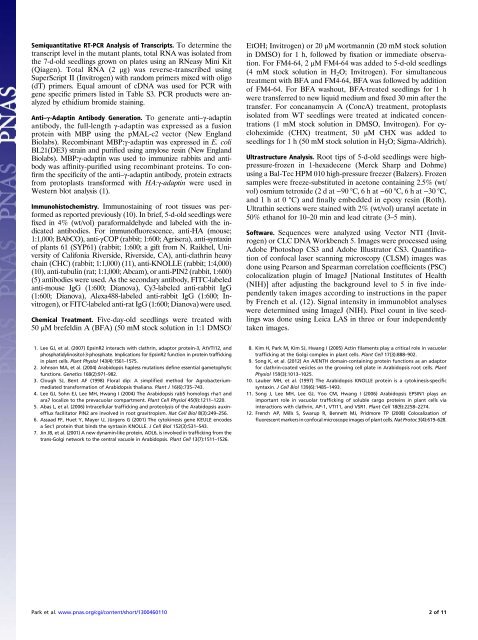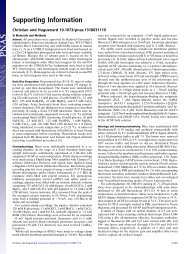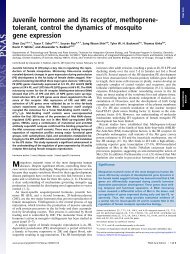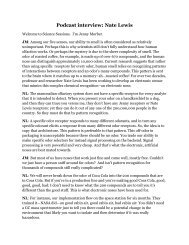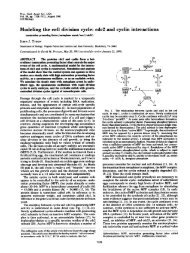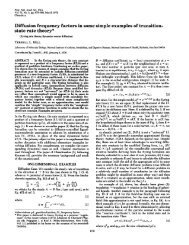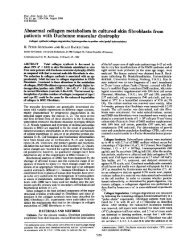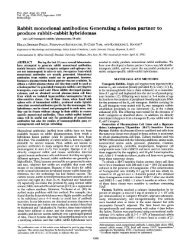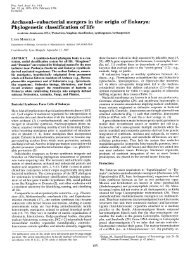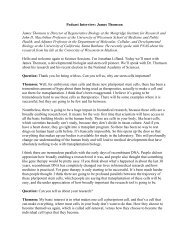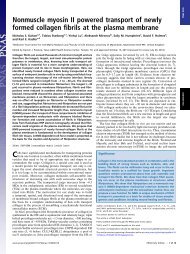Download Supporting Information (PDF)
Download Supporting Information (PDF)
Download Supporting Information (PDF)
You also want an ePaper? Increase the reach of your titles
YUMPU automatically turns print PDFs into web optimized ePapers that Google loves.
Semiquantitative RT-PCR Analysis of Transcripts. To determine the<br />
transcript level in the mutant plants, total RNA was isolated from<br />
the 7-d-old seedlings grown on plates using an RNeasy Mini Kit<br />
(Qiagen). Total RNA (2 μg) was reverse-transcribed using<br />
SuperScript II (Invitrogen) with random primers mixed with oligo<br />
(dT) primers. Equal amount of cDNA was used for PCR with<br />
gene specific primers listed in Table S3. PCR products were analyzed<br />
by ethidium bromide staining.<br />
Anti–γ-Adaptin Antibody Generation. To generate anti–γ-adaptin<br />
antibody, the full-length γ-adaptin was expressed as a fusion<br />
protein with MBP using the pMAL-c2 vector (New England<br />
Biolabs). Recombinant MBP:γ-adaptin was expressed in E. coli<br />
BL21(DE3) strain and purified using amylose resin (New England<br />
Biolabs). MBP:γ-adaptin was used to immunize rabbits and antibody<br />
was affinity-purified using recombinant proteins. To confirm<br />
the specificity of the anti–γ-adaptin antibody, protein extracts<br />
from protoplasts transformed with HA:γ-adaptin were used in<br />
Western blot analysis (1).<br />
Immunohistochemistry. Immunostaining of root tissues was performed<br />
as reported previously (10). In brief, 5-d-old seedlings were<br />
fixed in 4% (wt/vol) paraformaldehyde and labeled with the indicated<br />
antibodies. For immunofluorescence, anti-HA (mouse;<br />
1:1,000; BAbCO), anti-γCOP (rabbit; 1:600; Agrisera), anti-syntaxin<br />
of plants 61 (SYP61) (rabbit; 1:600; a gift from N. Raikhel, University<br />
of Califonia Riverside, Riverside, CA), anti-clathrin heavy<br />
chain (CHC) (rabbit; 1:1,000) (11), anti-KNOLLE (rabbit; 1:4,000)<br />
(10), anti-tubulin (rat; 1:1,000; Abcam), or anti-PIN2 (rabbit, 1:600)<br />
(5) antibodies were used. As the secondary antibody, FITC-labeled<br />
anti-mouse IgG (1:600; Dianova), Cy3-labeled anti-rabbit IgG<br />
(1:600; Dianova), Alexa488-labeled anti-rabbit IgG (1:600; Invitrogen),<br />
or FITC-labeled anti-rat IgG (1:600; Dianova) were used.<br />
Chemical Treatment. Five-day-old seedlings were treated with<br />
50 μM brefeldin A (BFA) (50 mM stock solution in 1:1 DMSO/<br />
EtOH; Invitrogen) or 20 μM wortmannin (20 mM stock solution<br />
in DMSO) for 1 h, followed by fixation or immediate observation.<br />
For FM4-64, 2 μM FM4-64 was added to 5-d-old seedlings<br />
(4 mM stock solution in H 2 O; Invitrogen). For simultaneous<br />
treatment with BFA and FM4-64, BFA was followed by addition<br />
of FM4-64. For BFA washout, BFA-treated seedlings for 1 h<br />
were transferred to new liquid medium and fixed 30 min after the<br />
transfer. For concanamycin A (ConcA) treatment, protoplasts<br />
isolated from WT seedlings were treated at indicated concentrations<br />
(1 mM stock solution in DMSO, Invitrogen). For cycloheximide<br />
(CHX) treatment, 50 μM CHX was added to<br />
seedlings for 1 h (50 mM stock solution in H 2 O; Sigma-Aldrich).<br />
Ultrastructure Analysis. Root tips of 5-d-old seedlings were highpressure-frozen<br />
in 1-hexadecene (Merck Sharp and Dohme)<br />
using a Bal-Tec HPM 010 high-pressure freezer (Balzers). Frozen<br />
samples were freeze-substituted in acetone containing 2.5% (wt/<br />
vol) osmium tetroxide (2 d at −90 °C, 6 h at −60 °C, 6 h at −30 °C,<br />
and 1 h at 0 °C) and finally embedded in epoxy resin (Roth).<br />
Ultrathin sections were stained with 2% (wt/vol) uranyl acetate in<br />
50% ethanol for 10–20 min and lead citrate (3–5 min).<br />
Software. Sequences were analyzed using Vector NTI (Invitrogen)<br />
or CLC DNA Workbench 5. Images were processed using<br />
Adobe Photoshop CS3 and Adobe Illustrator CS3. Quantification<br />
of confocal laser scanning microscopy (CLSM) images was<br />
done using Pearson and Spearman correlation coefficients (PSC)<br />
colocalization plugin of ImageJ [National Institutes of Health<br />
(NIH)] after adjusting the background level to 5 in five independently<br />
taken images according to instructions in the paper<br />
by French et al. (12). Signal intensity in immunoblot analyses<br />
were determined using ImageJ (NIH). Pixel count in live seedlings<br />
was done using Leica LAS in three or four independently<br />
taken images.<br />
1. Lee GJ, et al. (2007) EpsinR2 interacts with clathrin, adaptor protein-3, AtVTI12, and<br />
phosphatidylinositol-3-phosphate. Implications for EpsinR2 function in protein trafficking<br />
in plant cells. Plant Physiol 143(4):1561–1575.<br />
2. Johnson MA, et al. (2004) Arabidopsis hapless mutations define essential gametophytic<br />
functions. Genetics 168(2):971–982.<br />
3. Clough SJ, Bent AF (1998) Floral dip: A simplified method for Agrobacteriummediated<br />
transformation of Arabidopsis thaliana. Plant J 16(6):735–743.<br />
4. Lee GJ, Sohn EJ, Lee MH, Hwang I (2004) The Arabidopsis rab5 homologs rha1 and<br />
ara7 localize to the prevacuolar compartment. Plant Cell Physiol 45(9):1211–1220.<br />
5. Abas L, et al. (2006) Intracellular trafficking and proteolysis of the Arabidopsis auxinefflux<br />
facilitator PIN2 are involved in root gravitropism. Nat Cell Biol 8(3):249–256.<br />
6. Assaad FF, Huet Y, Mayer U, Jürgens G (2001) The cytokinesis gene KEULE encodes<br />
a Sec1 protein that binds the syntaxin KNOLLE. J Cell Biol 152(3):531–543.<br />
7. Jin JB, et al. (2001) A new dynamin-like protein, ADL6, is involved in trafficking from the<br />
trans-Golgi network to the central vacuole in Arabidopsis. Plant Cell 13(7):1511–1526.<br />
8. Kim H, Park M, Kim SJ, Hwang I (2005) Actin filaments play a critical role in vacuolar<br />
trafficking at the Golgi complex in plant cells. Plant Cell 17(3):888–902.<br />
9. Song K, et al. (2012) An A/ENTH domain-containing protein functions as an adaptor<br />
for clathrin-coated vesicles on the growing cell plate in Arabidopsis root cells. Plant<br />
Physiol 159(3):1013–1025.<br />
10. Lauber MH, et al. (1997) The Arabidopsis KNOLLE protein is a cytokinesis-specific<br />
syntaxin. J Cell Biol 139(6):1485–1493.<br />
11. Song J, Lee MH, Lee GJ, Yoo CM, Hwang I (2006) Arabidopsis EPSIN1 plays an<br />
important role in vacuolar trafficking of soluble cargo proteins in plant cells via<br />
interactions with clathrin, AP-1, VTI11, and VSR1. Plant Cell 18(9):2258–2274.<br />
12. French AP, Mills S, Swarup R, Bennett MJ, Pridmore TP (2008) Colocalization of<br />
fluorescent markers in confocal microscope images of plant cells. Nat Protoc 3(4):619–628.<br />
Park et al. www.pnas.org/cgi/content/short/1300460110<br />
2of11


